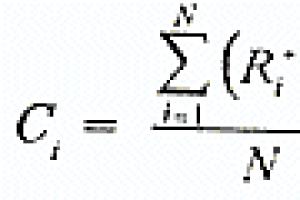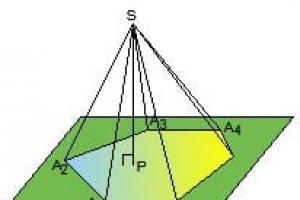Left a reply Guest
Ocean, or sea, currents are the forward movement of water masses in the oceans and seas, caused by various forces. Although the most significant cause of currents is wind, they can also form due to unequal salinity of individual parts of the ocean or sea, differences in water levels, and uneven heating of different areas of water areas. In the depths of the ocean there are vortices created by bottom irregularities, their size often reaches 100-300 km in diameter, they capture layers of water hundreds of meters thick. If the factors causing currents are constant, then a constant current is formed, and if they are episodic in nature, then a short-term, random flow is formed. According to the predominant direction, currents are divided into meridional, carrying their waters to the north or south, and zonal, spreading latitudinally. Currents in which the water temperature is higher than the average temperature for the same latitudes are called warm, lower - cold, and currents that have the same temperature as the surrounding waters are called neutral. Monsoon currents change their direction from season to season, depending on how the coastal monsoon winds blow. Countercurrents move towards neighboring, more powerful and extended currents in the ocean. The direction of currents in the World Ocean is influenced by the deflecting force caused by the rotation of the Earth - the Coriolis force. In the Northern Hemisphere, it deflects currents to the right, and in the Southern Hemisphere, to the left. The speed of currents on average does not exceed 10 m/s, and their depth extends to no more than 300 m. In the World Ocean, there are constantly thousands of large and small currents that circle the continents and merge into five giant rings. The system of currents in the World Ocean is called circulation and is associated primarily with the general circulation of the atmosphere. Ocean currents redistribute solar heat absorbed by masses of water. They transport warm water, heated by the sun's rays at the equator, to high latitudes, and cold water from the polar regions flows to the south thanks to currents. Warm currents contribute to an increase in air temperature, and cold currents, on the contrary, reduce it. Territories washed by warm currents are characterized by a warm and humid climate, and those near which cold currents pass are cold and dry. The most powerful current of the World Ocean is the cold current of the Western Winds, also called the Antarctic Circumpolar (from the Latin cirkum - around). The reason for its formation is strong and stable westerly winds blowing from west to east over vast areas of the Southern Hemisphere from temperate latitudes to the coast of Antarctica. This current covers an area 2500 km wide, extends to a depth of more than 1 km and transports up to 200 million tons of water every second. There are no large land masses along the path of the Western Winds, and it connects in its circular flow the waters of three oceans - the Pacific, Atlantic and Indian. The Gulf Stream is one of the largest warm currents in the Northern Hemisphere. It passes through the Gulf Stream and carries the warm tropical waters of the Atlantic Ocean to high latitudes. This gigantic flow of warm water largely determines the climate of Europe, making it soft and warm. Every second, the Gulf Stream carries 75 million tons of water (for comparison: the Amazon, the deepest river in the world, carries 220 thousand tons of water). At a depth of about 1 km, a countercurrent is observed under the Gulf Stream.
what is the main reason for the formation of surface ocean currents
Atmospheric circulation (wind system)
The main cause of surface currents in the open ocean is wind. Therefore, there is a close relationship between the directions and speeds of currents and prevailing winds. It is believed that the speed of ocean currents is about 10 times less than the speed of the wind that creates them.
In the tropical zone of the World Ocean, where stable trade winds of the north-eastern direction dominate in the northern hemisphere and south-eastern in the southern hemisphere, constant and powerful trade wind currents arise on both sides of the equator, which, under the influence of the deflecting force of the Earth's rotation (Coriolis force), acquire a latitudinal direction and cross the Pacific, Indian (except for its northern tropical part) and Atlantic oceans from east to west. In the northern hemisphere it is the Northern Trade Wind Current, in the southern hemisphere it is the Southern Trade Wind Current. Between these currents along the equator, an Equatorial countercurrent is formed, which, unlike trade winds, has a direction from west to east. Trade wind currents, encountering the eastern shores of the continents on their way, push up the waters (raise the level) and, under the influence of the configuration of the shores, turn to the right in the northern hemisphere and to the left in the southern hemisphere.
Objectives of the research work: Objectives of the research work: Objectives of the research work: Objectives of the research work: Explain the reasons for the formation of ocean currents Explain the reasons for the formation of ocean currents Get acquainted with the direction of surface and deep ocean currents Get acquainted with the direction of surface and deep ocean currents Learn to distinguish between warm and cold currents by description and on a map Learn to distinguish between warm and cold currents by description and on a map Name and show large ocean currents on a map Name and show large ocean currents on a map

Complete test tasks Complete test tasks. 1. Name the reason why tides are formed: t) attraction of the Ocean waters by the Moon; a) wind; d) earthquakes. 2. Does water move when the sea is rough? e) no; i) yes. 3. The stronger the wind and the deeper the sea, the h) the waves are larger; b) waves are smaller;. 4. The reason for the formation of a tsunami: a) wind; i) attraction of the ocean waters by the Moon; e) underwater earthquakes. 5. Where do earthquakes most often occur? e) on the plains; y) in the mountains; m) in seismic belts. 6. From the listed names of geographical objects, name the Bering Bay; i) Bengali; n) Gibraltar. 7. Of the listed seas, the saltiest is f) Mediterranean; i) Red; i) Baltic.

“My lesson plan and my successes” Last name, first name _______________________________________________ Testing Work in a contour map Restoring writing Participation in the lesson 5 points - 7 answers 4 points - 6 answers 3 points - answers For each marked course - 1 point 1 task - 1 point 2 task – 1 point 3 task – 1 point 4 task – 2 points 5 task – 2 points 3 points – worked actively and independently in the lesson 2 points – worked independently in the lesson and helped a friend 1 point – completed all the tasks correctly and independently My successes ? ? ? ? Maximum number of points – 19 Evaluation criterion: “5” points “4” points My total points - My mark -

Ocean (sea) currents - movement of water in the ocean or sea in the horizontal direction 1. Constant winds. 2.Relief of the ocean floor. 3. Outlines of continents.. 4. Rotation of the Earth around its axis. Object of research work: Reasons for the formation of currents in the ocean

The temperature of the current water is several degrees higher than the temperature of the surrounding water. The temperature of the current water is several degrees lower than the temperature of the surrounding water. Problematic question. The water temperature of the Peruvian Current off the coast of South America is 22 C o, and the North Atlantic Current is 2 C o. The first is considered cold, and the second is considered warm. Why?


Large ocean currents OceanWarm currentsCold currents PacificNorth Trade Wind South Trade Wind Kuroshio North Pacific California Peruvian West winds AtlanticNorth Trade Wind South Trade Wind Gulf Stream Brazilian North Atlantic Labrador Canary Benguela West winds IndianSouth Trade Wind Monsoon Mozambique Somali West winds North Arctic East Greenland


Let's summarize the results of the research work What is called oceanic? I succeeded most of all... During the lesson I... I didn’t know... - Now I know...). I realized that...It was difficult...with the current? For what reasons do currents arise? What is the main reason for the occurrence of currents? What is the pattern of distribution of currents on the surface of the globe? What types of currents are there? Why study ocean currents?

1. A current is…… 2. The main reason for the formation of currents is…… A cold current is indicated by an arrow of …….. color, and a warm one - ………. 4. A cold current has a water temperature ……… than that of the surrounding water flow. 5. Here are some ocean currents: a) Warm: b) Cold: A mariner’s report Restore the damaged text

Check your work 1. Current is the movement of water in an ocean or sea in a horizontal direction. 2. The main reason for the formation of currents is wind. 3. A cold current is indicated by a blue arrow, and a warm current by a red arrow. 4. A cold current has a lower water temperature than the surrounding water flow. 5. Here are some ocean currents: a) Warm: b) Cold:

Homework 1. Study the materials in the paragraph Create a route for a sea voyage in the Indian Ocean using currents. Draw it on a contour map. 3. Complete task 5 at the end of paragraph 27.

Mariners learned about the presence of ocean currents almost as soon as they began to plow the waters of the World Ocean. True, the public paid attention to them only when, thanks to the movement of ocean waters, many great geographical discoveries were made, for example, Christopher Columbus sailed to America thanks to the North Equatorial Current. After this, not only sailors, but also scientists began to pay close attention to ocean currents and strive to study them as best and deeply as possible.
Already in the second half of the 18th century. the sailors studied the Gulf Stream quite well and successfully applied the acquired knowledge in practice: from America to Great Britain they walked with the current, and in the opposite direction they kept a certain distance. This allowed them to stay two weeks ahead of ships whose captains were not familiar with the area.
Ocean or sea currents are large-scale movements of water masses in the World Ocean at speeds from 1 to 9 km/h. These streams do not move chaotically, but in a certain channel and direction, which is the main reason why they are sometimes called rivers of the oceans: the width of the largest currents can be several hundred kilometers, and the length can reach several thousand.
It has been established that water flows do not move straight, but deviate slightly to the side and are subject to the Coriolis force. In the Northern Hemisphere they almost always move clockwise, in the Southern Hemisphere it’s the other way around.. At the same time, currents located in tropical latitudes (they are called equatorial or trade winds) move mainly from east to west. The strongest currents were recorded along the eastern coasts of the continents.
Water flows do not circulate on their own, but are set in motion by a sufficient number of factors - the wind, the rotation of the planet around its axis, the gravitational fields of the Earth and the Moon, the bottom topography, the outlines of continents and islands, the difference in temperature indicators of water, its density, depth in different places in the ocean and even its physical and chemical composition.
Of all types of water flows, the most pronounced are the surface currents of the World Ocean, the depth of which is often several hundred meters. Their occurrence was influenced by trade winds constantly moving in tropical latitudes in a west-east direction. These trade winds form the huge flows of the North and South Equatorial Currents near the equator. A smaller part of these flows returns to the east, forming a countercurrent (when the movement of water occurs in the opposite direction from the movement of air masses). Most of them, when colliding with continents and islands, turn to the north or south.
Warm and cold water currents
It must be taken into account that the concepts of “cold” or “warm” currents are conditional definitions. So, despite the fact that the temperature of the water flows of the Benguela Current, which flows along the Cape of Good Hope, is 20°C, it is considered cold. But the North Cape Current, which is one of the branches of the Gulf Stream, with temperatures from 4 to 6 ° C, is warm.







This happens because cold, warm and neutral currents got their names based on a comparison of the temperature of their water with the temperature of the surrounding ocean:
- If the temperature indicators of the water flow coincide with the temperature of the surrounding waters, such a flow is called neutral;
- If the temperature of the currents is lower than the surrounding water, they are called cold. They usually flow from high latitudes to low latitudes (for example, the Labrador Current), or from areas where, due to high river flows, ocean water has a reduced salinity of surface waters;
- If the temperature of the currents is warmer than the surrounding water, then they are called warm. They move from tropical to subpolar latitudes, for example, the Gulf Stream.
Main water flows
At the moment, scientists have recorded about fifteen major oceanic water flows in the Pacific, fourteen in the Atlantic, seven in the Indian and four in the Arctic Ocean.
It is interesting that all currents of the Arctic Ocean move at the same speed - 50 cm/sec, three of them, namely the West Greenland, West Spitsbergen and Norwegian, are warm, and only the East Greenland is a cold current.
But almost all oceanic currents of the Indian Ocean are warm or neutral, with the Monsoon, Somali, Western Australian and Cape Agulhas current (cold) moving at a speed of 70 cm/sec, the speed of the rest varies from 25 to 75 cm/sec. The water flows of this ocean are interesting because, together with the seasonal monsoon winds, which change their direction twice a year, the oceanic rivers also change their course: in winter they mainly flow to the west, in summer - to the east (a phenomenon characteristic only of the Indian Ocean ).
Since the Atlantic Ocean stretches from north to south, its currents also have a meridional direction. Water flows located in the north move clockwise, in the south - counterclockwise.







A striking example of the flow of the Atlantic Ocean is the Gulf Stream, which, starting in the Caribbean Sea, carries warm waters to the north, breaking up into several side streams along the way. When the waters of the Gulf Stream find themselves in the Barents Sea, they enter the Arctic Ocean, where they cool and turn south in the form of the cold Greenland Current, after which at some stage they deviate to the west and again join the Gulf Stream, forming a vicious circle.
The currents of the Pacific Ocean are mainly in a latitudinal direction and form two huge circles: northern and southern. Since the Pacific Ocean is extremely large, it is not surprising that its water flows have a significant impact on much of our planet.
For example, trade wind water currents transport warm waters from the western tropical coasts to the eastern ones, which is why in the tropical zone the western part of the Pacific Ocean is much warmer than the opposite side. But in the temperate latitudes of the Pacific Ocean, on the contrary, the temperature is higher in the east.
Deep Currents
For quite a long time, scientists believed that deep ocean waters were almost motionless. But soon special underwater vehicles discovered both slow and fast-flowing water streams at great depths.
For example, under the Equatorial Current of the Pacific Ocean at a depth of about one hundred meters, scientists have identified the underwater Cromwell Current, moving eastward at a speed of 112 km/day.
Soviet scientists found a similar movement of water flows, but in the Atlantic Ocean: the width of the Lomonosov Current is about 322 km, and the maximum speed of 90 km/day was recorded at a depth of about one hundred meters. After this, another underwater flow was discovered in the Indian Ocean, although its speed turned out to be much lower - about 45 km/day.
The discovery of these currents in the ocean gave rise to new theories and mysteries, the main one of which is the question of why they appeared, how they were formed, and whether the entire area of the ocean is covered by currents or there is a point where the water is still.
The influence of the ocean on the life of the planet
The role of ocean currents in the life of our planet can hardly be overestimated, since the movement of water flows directly affects the planet’s climate, weather, and marine organisms. Many compare the ocean to a huge heat engine driven by solar energy. This machine creates a constant exchange of water between the surface and deep layers of the ocean, providing it with oxygen dissolved in the water and influencing the life of marine inhabitants.
This process can be traced, for example, by considering the Peruvian Current, which is located in the Pacific Ocean. Thanks to the rise of deep waters, which lift phosphorus and nitrogen upward, animal and plant plankton successfully develop on the ocean surface, resulting in the organization of a food chain. Plankton is eaten by small fish, which, in turn, become prey to larger fish, birds, and marine mammals, which, given such food abundance, settle here, making the region one of the most highly productive areas of the World Ocean.
It also happens that a cold current becomes warm: the average ambient temperature rises by several degrees, causing warm tropical showers to fall on the ground, which, once in the ocean, kill fish accustomed to cold temperatures. The result is disastrous - a huge amount of dead small fish ends up in the ocean, large fish leave, fishing stops, birds leave their nesting places. As a result, the local population is deprived of fish, crops destroyed by heavy rains, and profits from the sale of guano (bird droppings) as fertilizer. It can often take several years to restore the previous ecosystem.
Previously, before the invention of radio, a bottle sealed with wax was thrown from a ship that was wrecked, with a note in it indicating the location of the disaster. The sailors hoped that maybe the bottle would be noticed from another ship and they would be rescued. Many such bottles in those days were caught off the coast of the Scandinavian Peninsula, although, judging by the notes, they were thrown thousands of kilometers from the place of discovery, somewhere in the central part of the Atlantic Ocean.
When scientists began to compare the map, where the directions of the winds over the oceans are indicated by arrows, with the map where the ocean currents are indicated, it turned out that these directions almost coincided. Thus, in our time it is easy to explain why bottles abandoned in the central part of the Atlantic Ocean were found off the coast of the Scandinavian Peninsula.
- Ocean currents are formed mainly under the influence constant winds. That is, the wind drives water and forces it to move in a certain direction.
- Tides are also one of the causes of sea currents.
- Due to different density of water in different parts of water basins, water can also move over long distances.
Here, on both sides of the Equator, constant winds blow from Africa to America. Under the influence of these winds, water flows along the Equator, some of it falls into Gulf of Mexico, from where it rushes in a powerful stream into the Atlantic Ocean and further to the shores of Europe. Off the coast of America this current is called the Gulf Stream. The waters of the Gulf Stream flow at speeds of up to 10 km per hour. The width of the water flow is from 75 to 120 km, and the depth is 700 m. It is calculated that all the rivers of the globe taken together carry less water than the Gulf Stream. In the northern part of the Atlantic Ocean it is called the North Atlantic. This current is warm, since it is born in the warmest part of the Atlantic Ocean.
Cold currents
The cold Labrador Current passes from the Arctic Ocean past Greenland to the Labrador Peninsula. The water of this current is much colder than the surrounding water.








